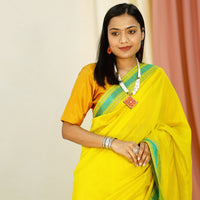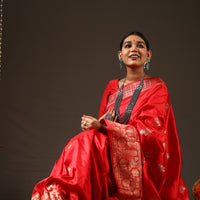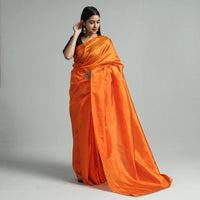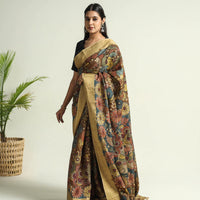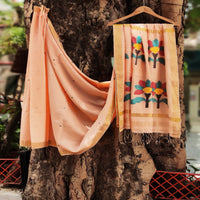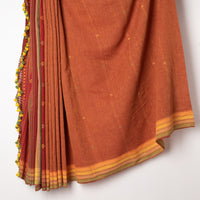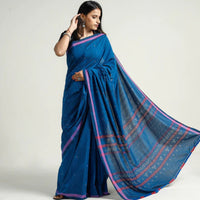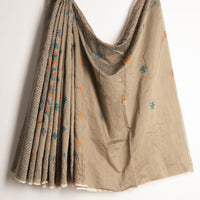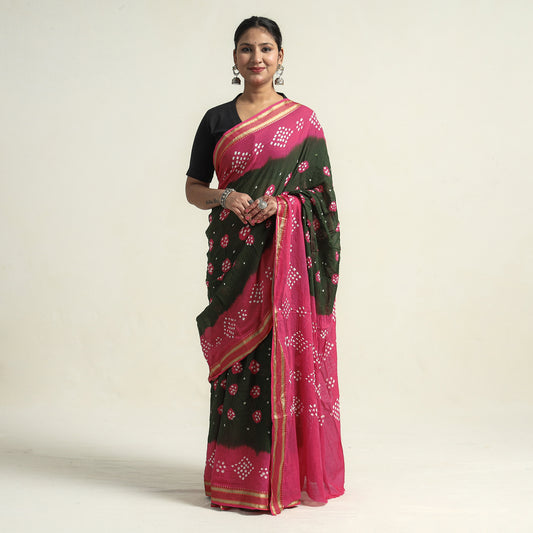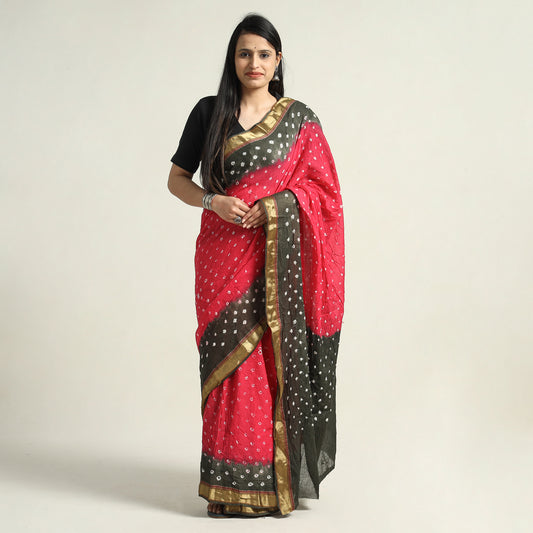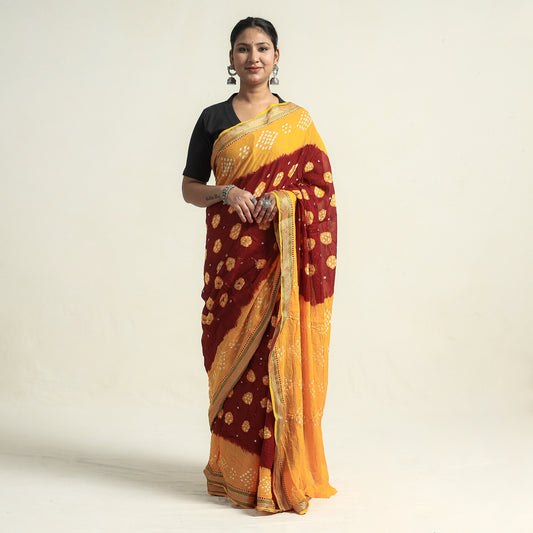The Timeless Art of Bandhani: A Heritage Woven in Every Thread
Bandhani, also known as Bandhej, is more than just a textile—it's a centuries-old tradition, a vibrant expression of Indian culture, and a testament to the skill and dedication of artisans from Gujarat and Rajasthan. This intricate tie-and-dye art form, characterized by its delicate patterns and vivid colors, has been a part of India’s rich textile heritage for over 4,000 years. At iTokri, we take immense pride in offering a collection of Bandhani sarees that are not only stunningly beautiful but also carry the legacy of generations of artisans.
Origin and Evolution: The Birthplace of Bandhani
The origins of Bandhani can be traced back to the Indus Valley Civilization, where evidence of this dyeing technique has been discovered on ancient fabrics. Gujarat and Rajasthan have since become the primary hubs of this craft, with each region developing its unique style and patterns. In Gujarat, the city of Jamnagar is particularly renowned for its Bandhani sarees, where artisans have mastered the technique of tying thousands of tiny knots to create intricate designs.
The craft of Bandhani is deeply intertwined with the cultural and social fabric of these regions. Traditionally, Bandhani sarees were worn during significant life events such as weddings, births, and festivals. The patterns and colors of these sarees were often symbolic, with red representing prosperity and green signifying fertility. Over time, Bandhani has evolved, embracing modern aesthetics while preserving its traditional essence.
The Artisans Behind the Craft: Guardians of a Living Tradition
At the heart of every Bandhani saree are the artisans who have dedicated their lives to perfecting this art. These skilled craftsmen and women, often from rural communities, have inherited the craft from their ancestors. The process of making a Bandhani saree is labor-intensive and time-consuming, requiring both precision and creativity.
Artisans begin by drawing the design on the fabric, which is then tied into tiny knots using threads. These knots resist the dye, creating the intricate patterns for which Bandhani is famous. The fabric is then dyed, often in multiple colors, and the knots are untied to reveal the final design. The entire process can take anywhere from a few days to several weeks, depending on the complexity of the design.
One such artisan is Rekhaben from Kutch, Gujarat. Rekhaben learned the craft from her mother and has been practicing it for over 30 years. Despite the challenges of sustaining a livelihood through traditional crafts in today’s fast-paced world, Rekhaben remains committed to preserving the art of Bandhani. Through iTokri, artisans like Rekhaben are able to reach a global audience, ensuring that their craft continues to thrive.
Bandhani Sarees at iTokri: A Blend of Tradition and Modernity
At iTokri, our Bandhani sarees are curated to offer a perfect blend of tradition and modernity. Each saree is a masterpiece, handcrafted by artisans who pour their heart and soul into their work. Whether it's the luxurious Gaji silk Bandhani sarees or the more casual cotton varieties, every piece in our collection is a reflection of India’s rich cultural heritage.
Our collection includes a wide range of Bandhani sarees, from the traditional heavy Bandhej sarees, perfect for weddings and festive occasions, to lightweight Bandhani sarees ideal for everyday wear. We also offer Bandhani silk sarees, which are known for their soft texture and vibrant colors, making them a popular choice among saree enthusiasts.
Cultural Significance: More Than Just a Saree
Bandhani sarees are more than just a piece of clothing; they are a cultural symbol. In many Indian communities, these sarees are an essential part of the bridal trousseau, passed down from generation to generation as a family heirloom. The intricate patterns on a Bandhani saree often carry deep cultural meanings. For example, the ‘chandrokhani’ pattern, which features circular designs, is said to represent the moon and is considered auspicious.
In Rajasthan, Bandhani sarees are worn during the monsoon festival of Teej, symbolizing the onset of the rainy season. The vibrant green and yellow colors of these sarees are believed to bring prosperity and fertility. In Gujarat, the red Bandhani saree is a staple for brides, symbolizing marital bliss and good fortune.
iTokri’s Commitment to Sustainability and Ethical Practices
At iTokri, we believe in the importance of sustainability and ethical practices. We are committed to supporting the artisans who keep traditional crafts like Bandhani alive. Every purchase from our Bandhani collection directly contributes to the livelihoods of these artisans, helping them sustain their craft in a rapidly changing world.
Our commitment to sustainability extends beyond supporting artisans. We use eco-friendly packaging materials, ensuring that our products have minimal environmental impact. The dyes used in our Bandhani sarees are often natural and organic, reducing the environmental footprint of the dyeing process.
Why Choose iTokri?
When you choose a Bandhani saree from iTokri, you’re not just buying a piece of clothing; you’re investing in a piece of history, supporting sustainable practices, and contributing to the preservation of India’s cultural heritage. Here’s why iTokri stands out:
-
Authenticity and Trust: Every product at iTokri is guaranteed to be authentic, ethically sourced, and of the highest quality. We work directly with artisans, ensuring that they receive fair compensation for their work.
-
Global Reach, Local Touch: While iTokri serves a global audience, our approach remains deeply rooted in local practices. We offer a platform where traditional techniques meet modern aesthetics, bringing the best of India to the world.
The Future of Bandhani: Innovation and Adaptation
As the world changes, so does the art of Bandhani. Today, artisans are experimenting with new designs, techniques, and materials to keep the craft relevant in modern times. At iTokri, we encourage this spirit of innovation while staying true to the roots of Bandhani. Our collection features both traditional designs and contemporary interpretations, catering to a wide range of tastes and preferences.
One exciting development in the world of Bandhani is the use of eco-friendly dyes and sustainable fabrics. Artisans are increasingly turning to organic cotton and natural dyes, reducing the environmental impact of their craft. This not only makes Bandhani more sustainable but also adds to the richness and depth of the colors.
Human Stories: The Heartbeat of iTokri
Behind every Bandhani saree is a story—a story of dedication, skill, and resilience. Take the story of Lakshmiben from Bhuj, for example. A widow with three children, Lakshmiben struggled to make ends meet after her husband’s death. She turned to Bandhani, a craft she learned from her mother, as a means to support her family. Today, thanks to platforms like iTokri, Lakshmiben’s sarees are sold across the world, providing her with a stable income and a renewed sense of purpose.
Stories like Lakshmiben’s are at the heart of what we do at iTokri. We believe in empowering artisans, giving them the tools and platforms they need to succeed in a global marketplace. By sharing these stories, we aim to create a deeper connection between our customers and the products they purchase.
Join the iTokri Family: Celebrate Craftsmanship and Culture
At iTokri, we invite you to join us in celebrating the rich tapestry of Indian craftsmanship. Each Bandhani saree in our collection is a testament to the skill and dedication of artisans who have kept this craft alive for generations. By choosing iTokri, you’re not just buying a saree; you’re becoming a part of a community that values authenticity, sustainability, and cultural preservation.
Call to Action: Explore the Beauty of Bandhani
Discover the timeless beauty of Bandhani sarees at iTokri. Shop our exclusive collection today and bring home a piece of India’s rich cultural heritage. With every purchase, you’re supporting artisans, preserving a cultural legacy, and embracing the true essence of handcrafted Indian products.
Dil se shukriya for reading it till now :) You seem to be a true Saree lover :)
Hello! My name is Nitin and with Jia i am one of the founders at iTokri :)
We both have been true saree lovers since 2012 and a decade has passed since we started on this journey with love and passion.
Sarees have been one of the best-selling categories on iTokri since we ventured on to build the most diverse catalog of Indian Sarees on the internet keeping the spirit of artisanal heritage alive. Jia and myself travelled extensively through India's weavers communities trying to build a most authentic saree shop online with integrity and transparency at its core. With so much being crafted in India, we are not yet there what we aimed for... the journey seems to on and i can surely tell you its most exciting one!
We welcome you to explore our elaborated full saree catalog " here "
I would highly recommend you visit our other textile crafts too including running fabrics ofcourse and dress materials, dupattas, stoles, blouse materials and beautiful bedcovers, cushion covers and more, cherishing the skills of Indian Master Artisans.
Recently we also launched our exclusive garments label "ITOKRI CASUALS", Jia is heading the designs there, i would like to welcome you to explore our Kurtas, Suit Sets, Dresses, Co-ord Sets, Night Suits and much more.
It would be good to also check out our non-textile crafts in Jewellery, Home Decor, Stationery, Bags, and Kitchen catalogs .
We have also created a comprehensive & dedicated landing page for all the Indian crafts we have listed on iTokri here - CRAFTS OF INDIA
If you want to directly reach out to me, you can drop me an email at nitin@itokri.com and i shall be happy to connect with you :)
I wish you a happy browsing at iTokri! Looking forward to your lovely support!
FAQ of Bandhani Sarees Collection
1. What is Bandhani Saree and how is it different from other sarees?
Bandhani, also known as Bandhej, is a traditional Indian saree crafted using a tie-and-dye technique. The unique aspect of Bandhani sarees is the intricate pattern of tiny knots tied with thread before dyeing. This process creates beautiful, distinct patterns that set Bandhani sarees apart from other types of sarees. Unlike printed sarees, Bandhani involves manual craftsmanship, making each piece unique. The technique is primarily practiced in the states of Gujarat and Rajasthan, making it a cultural treasure of these regions.
2. How is a Bandhani Saree made?
The making of a Bandhani saree is a time-consuming and intricate process. It starts with selecting high-quality fabric, often silk or cotton. The fabric is then tied into tiny knots using thread in a specific pattern. These knots are the key to the tie-and-dye process, as they resist the dye when the fabric is immersed in color. After dyeing, the threads are removed to reveal the unique pattern of dots and designs. This process can be repeated multiple times with different colors to create more complex patterns. The art requires immense precision and skill, often passed down through generations of artisans.
3. What are the different types of Bandhani Sarees available?
Bandhani sarees come in various types, each characterized by the fabric used and the patterns created. Some popular types include:
-
Gaji Silk Bandhani: Known for its luxurious texture and vibrant colors, Gaji silk is a preferred choice for festive and wedding wear.
-
Cotton Bandhani: Lightweight and breathable, cotton Bandhani sarees are perfect for everyday wear and hot climates.
-
Heavy Bandhej Saree: These sarees are richly adorned and often feature multiple colors and intricate patterns, making them ideal for special occasions.
-
Bandhani on Georgette or Chiffon: These fabrics offer a modern twist to the traditional Bandhani, making them popular among younger audiences.
4. What cultural significance do Bandhani Sarees hold?
Bandhani sarees hold immense cultural significance in India, particularly in Gujarat and Rajasthan. Traditionally, Bandhani sarees are worn during auspicious occasions such as weddings, festivals, and religious ceremonies. The dots and patterns in a Bandhani saree often symbolize prosperity, fertility, and good fortune. In many communities, the color and pattern of a Bandhani saree carry specific meanings, such as red for brides and maroon for married women. The craft is deeply embedded in the cultural fabric of these regions, reflecting the rich heritage and artistry of India.
5. How do I care for and maintain a Bandhani Saree?
Bandhani sarees require special care to maintain their vibrant colors and intricate patterns. Here are some tips:
-
Handwash Separately: Always handwash your Bandhani saree in cold water using a mild detergent. Avoid washing it with other clothes to prevent color bleeding.
-
Avoid Wringing: Do not wring the saree to remove excess water. Instead, gently squeeze and lay it flat to dry in the shade.
-
Iron Carefully: If needed, iron the saree on a low setting on the reverse side to avoid damaging the fabric or the patterns.
-
Store Properly: Store your Bandhani saree in a cool, dry place. It’s best to wrap it in a cotton cloth to protect it from dust and moisture.
6. Can Bandhani Sarees be worn year-round, and how can I style them?
Yes, Bandhani sarees are versatile and can be worn year-round. Here’s how you can style them for different seasons:
-
Summer: Opt for a lightweight cotton Bandhani saree, paired with minimalistic jewelry and a simple blouse to keep cool.
-
Winter: Choose a heavier fabric like Gaji silk and accessorize with a warm shawl and traditional jewelry for an elegant look.
-
Festivals & Weddings: Go for a richly adorned Bandhani saree in vibrant colors like red or maroon. Pair it with gold jewelry, a matching blouse, and a traditional hairstyle to complete the festive look.
Bandhani sarees can be styled traditionally or with a modern twist, making them suitable for various occasions.
7. Are Bandhani Sarees sustainable and eco-friendly?
Yes, Bandhani sarees are considered sustainable and eco-friendly, particularly when made using natural dyes and traditional techniques. The tie-and-dye process itself is low-impact, requiring minimal use of chemicals and water. At iTokri, we ensure that our Bandhani sarees are made following sustainable practices, supporting both the environment and the artisans. By choosing a Bandhani saree, you are not only embracing a piece of cultural heritage but also making a conscious choice towards sustainable fashion.
8. What makes iTokri’s Bandhani Sarees unique?
iTokri’s Bandhani sarees stand out for several reasons:
-
Authenticity: Each saree is handcrafted by skilled artisans, ensuring that every piece is unique and rooted in tradition.
-
Quality: We use only high-quality fabrics and natural dyes, ensuring the sarees are durable and maintain their vibrant colors over time.
-
Support for Artisans: By purchasing from iTokri, you directly support the livelihoods of local artisans, helping to preserve this traditional craft.
-
Diverse Collection: Our collection offers a wide range of Bandhani sarees, from traditional designs to contemporary styles, catering to different tastes and occasions.
9. How do I know if a Bandhani Saree is authentic?
To ensure that your Bandhani saree is authentic, look for the following signs:
-
Pattern: Authentic Bandhani sarees will have irregularities in the patterns, as each dot is hand-tied and hand-dyed. Perfectly uniform dots may indicate a machine-made product.
-
Fabric: Traditional Bandhani sarees are made from natural fabrics like silk or cotton. Check the label or ask the seller about the fabric type.
-
Color Bleeding: Genuine Bandhani sarees made with natural dyes may experience slight color bleeding during the first wash. This is normal and does not affect the overall quality of the saree.
-
Feel: Authentic Bandhani sarees have a certain weight and texture due to the tie-and-dye process. The fabric should feel substantial yet soft to the touch.
When buying from iTokri, you can be assured of the authenticity and quality of your Bandhani saree.
10. Can I return or exchange a Bandhani Saree if I am not satisfied?
At iTokri, customer satisfaction is our top priority. If you are not completely satisfied with your purchase, we offer a hassle-free return or exchange policy. Here’s how it works:
-
Return: You can return the saree within a specified period (typically 7-10 days) from the date of delivery, provided it is unused, unwashed, and in its original condition.
-
Exchange: If you wish to exchange the saree for a different color or style, you can do so within the same period. We’ll guide you through the process to make it as easy as possible.
We are thrilled to show you our elaborated and authentic handcrafted saree collection :)
Our Bestsellers other than Bandhani Sarees you saw above are : Kalamkari Sarees, Ajrakh Hand Block Print Silk & Cotton Sarees, Madhubani Painted Sarees, Original Mangalgiri Handloom Sarees, Pochampally Ikat Sarees of Andhra & Telangana, Sambalpuri Ikat Sarees of Odisha, Hand Batik Printed Silk & Cotton Sarees, Pure Cotton Sarees, Handwoven Pure Tussar Silk & Cotton Sarees
Check All Saree Collection " here"
बांधनी: हर धागे में बसी एक शाश्वत धरोहर
बांधनी, जिसे बंधेज भी कहा जाता है, सिर्फ एक वस्त्र नहीं, बल्कि भारत की सांस्कृतिक धरोहर का जीवंत प्रतीक है। गुजरात और राजस्थान के कुशल कारीगरों द्वारा इसे तैयार किया जाता है। बांधनी का इतिहास 4000 साल पुराना है, और इसकी उत्पत्ति सिंधु घाटी सभ्यता से मानी जाती है। इस परंपरागत शिल्प में कपड़े को छोटी-छोटी गांठों में बांधकर रंगा जाता है, जिससे विशिष्ट पैटर्न बनते हैं।
गुजरात के जामनगर और राजस्थान के कारीगरों ने इस कला को पीढ़ियों से संजोया है। iTokri पर मिलने वाली बांधनी साड़ियां इन कारीगरों की मेहनत और कला का सजीव उदाहरण हैं। ये साड़ियां केवल सुंदर नहीं, बल्कि पीढ़ियों से चली आ रही धरोहर का प्रतीक भी हैं। विभिन्न प्रकार की बांधनी साड़ियों में गाजी सिल्क, कॉटन, और हेवी बंधेज शामिल हैं, जिन्हें शादी, त्योहारों और अन्य विशेष अवसरों के लिए पहना जाता है।
iTokri न केवल इन साड़ियों की सुंदरता को प्रदर्शित करता है, बल्कि उनके पीछे के कारीगरों की मेहनत और समर्पण को भी सम्मानित करता है। iTokri की बांधनी साड़ियां न केवल पारंपरिक हैं, बल्कि आधुनिकता का भी स्पर्श रखती हैं। इस संग्रह में पारंपरिक और आधुनिक दोनों प्रकार की डिज़ाइन शामिल हैं, जो हर उम्र और रुचि के लोगों के लिए उपयुक्त हैं।
iTokri की बांधनी साड़ियों की ख़ासियत यह है कि वे पूरी तरह से हस्तनिर्मित हैं, और उनकी खरीद से आप न केवल एक अद्वितीय वस्त्र प्राप्त करते हैं, बल्कि उन कारीगरों के जीवन में भी सकारात्मक बदलाव लाते हैं, जो इस कला को जीवित रखे हुए हैं।
This content has been thoughtfully generated with some help of AI tools available on the web and properly moderated with expert inputs to make it authentic and reader friendly. bahut jyada mehnat lagti hai usme bhi :)
The purpose of the content is to help you understand the product, its source and the people working behind it... and also the history and legacy of Indian craftsmanship. Its little detailed but i am sure worth the read if you have reached here already!
If you think that this content is helpful, do share your feedback on
whatsapp by clicking " here " or write to us
on the dedicated email id : content@itokri.com :)
If you don't find it helpful, we would love to hear some feedback from you and shall improve on our content generation strategy for sure.
The primary goal of iTokri is to enrich your learning around crafts and authentic products our beautiful country makes!












